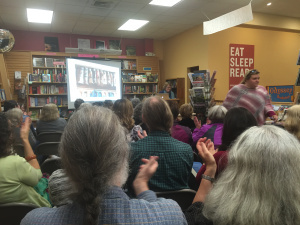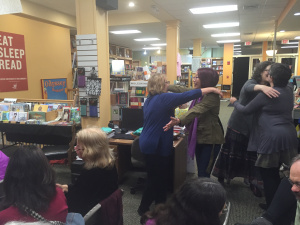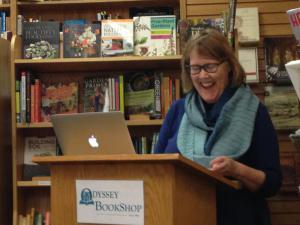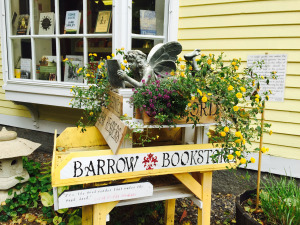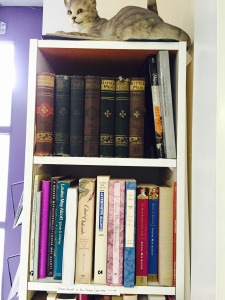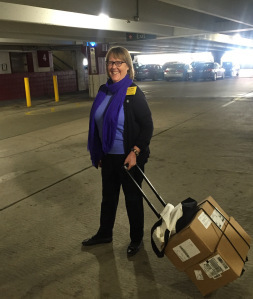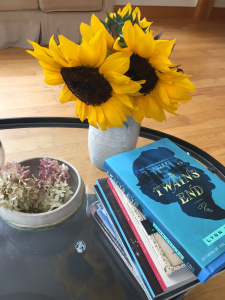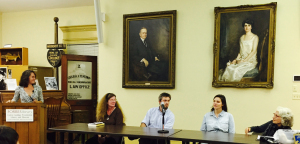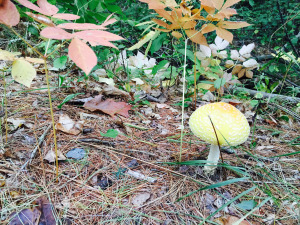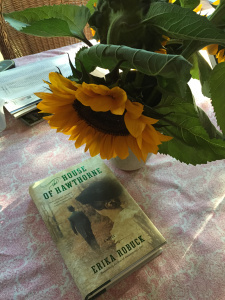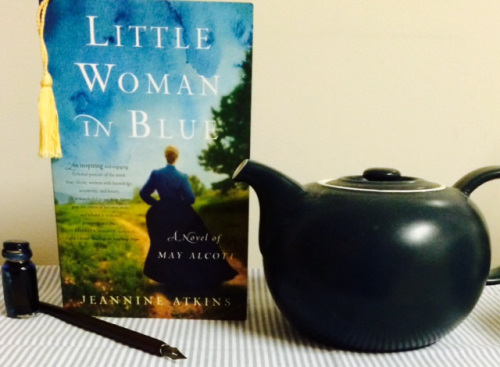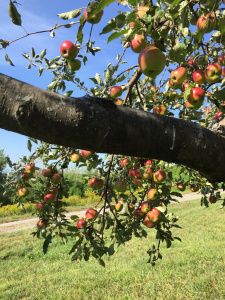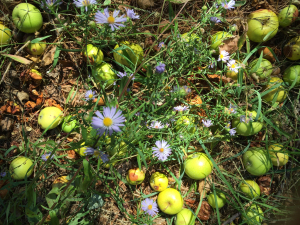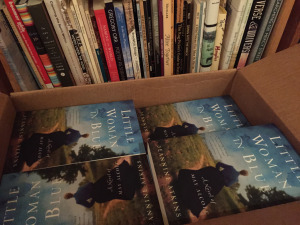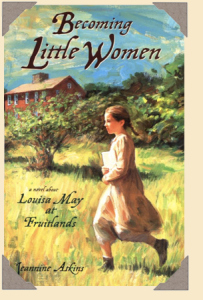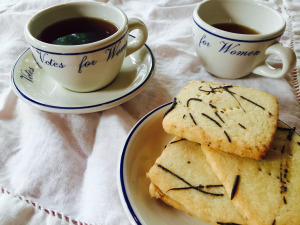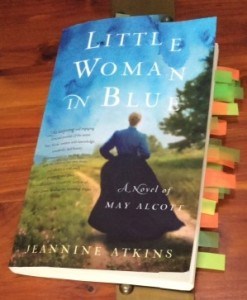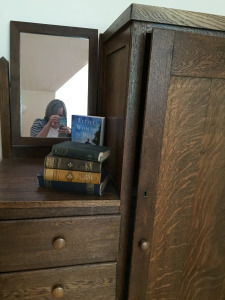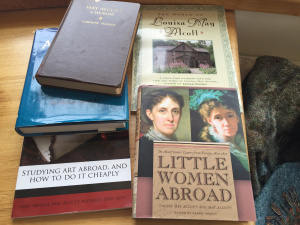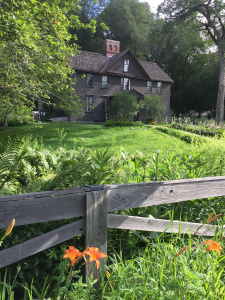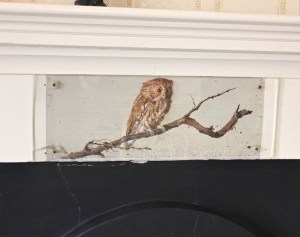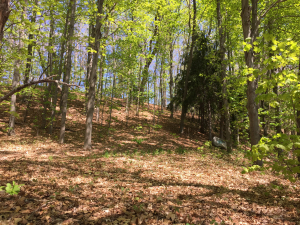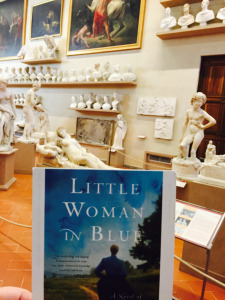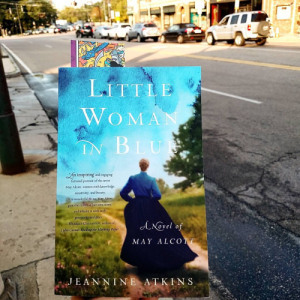Jeannine Atkins's Blog, page 8
October 14, 2015
Launching a Book around Massachusetts
Huge thanks to the good people at the Odyssey Bookshop and so many dear friends and family for making my launch of Little Woman in Blue a happy evening. I guess you can see from the pictures I’m having a little fun talking about May, and getting to hug Debbi Michiko Florence here, and also a friend from childhood, others from college, students turned friends, writing pals, and cherished family.
Now I’m looking forward to taking May Alcott to her hometown of Concord, Massachusetts. I’ll read a bit from my novel and talk about doing research in and about that unique town at Barrow Bookstore 79 Main St. this Saturday Oct. 17 at 4:30.
Here’s a peek at just some of the shop’s books on the Alcott family, right next to the purple door. The women who run this store know a lot about the family, which will make discussion extra special. Also, I guarantee some laughs. Hope to see some of you!


October 11, 2015
Little Woman in Blue: A Book Leaves Home
The leaves are turning in Massachusetts, and I’m finding some balance, making time to read and mull between marketing efforts, coaxing my introvert and extrovert selves to hold hands. One fear is facing blank pages and another is sending out books to reviewers. Can I make sense of my own thoughts? Will they matter to anyone else? I’m grateful for kind words about Little Woman in Blue from my local paper, The Daily Hampshire Gazette. And thrilled that Ingram hosted me at the New England Independent Booksellers Association fall conference. I had fun signing books and meeting intrepid booksellers.
Thanks to author Lisa Papademetriou, whose A Tale of Highly Unusual Magic is just out, for the picture above and the less glam shot below from Megan Lambert, author of Reading Picture Books with Children, who kindly asked if someone had taken a photo of me signing before snapping this. There’s the victory of getting a book published and another of finding your car in a big convention center garage.
I’ve felt so welcomed into the community of historical fiction lovers and am in awe of bloggers who’ve started conversations with me and with their readers. I thank Diana for hosting me on her blog, Sending You to Yesteryear One Book at a Time, where I talk about origins of my novel, favorite reading, and give advice to aspiring novelists. At CT Commie Tiger Mommy, Marina and I consider Victorian fashions, suffrage, and sisterly rivalry. It was great to engage with a history-loving artist at American Girls Art Club in Paris .. and Beyond. Her questions about women (who gets called “difficult?”), art and history (what are some particular challenges women face in studios?) brought to mind some of the conversations May Alcott might have had with Mary Cassatt.
I’m really looking forward to my book launch at the Odyssey Bookshop this Tuesday Oct. 13 at 7 p.m. As I write, that’s also called tomorrow. I’ll talk a bit about my book’s origins in not quite ancient history, read a few pages, and show some slides of May’s work. There will be cider, cookies, candy corn, and book signing. Meanwhile, baking and reading. I have recipes and printed pages, but there’s always a reminder of a sprawl of eggs, butter, words: the delightful mess where so much begins.


October 9, 2015
Nature Writing at Forbes Library
Earth and Cosmos: Nature Writing was the first in a series of readings at Forbes Library in Northampton, MA, organized by Naila Moreira, the new writer in residence. Five writers read short pieces. Katie Koerten who teaches at the Hitchcock Center for the Environment, read from a series of columns regularly published in The Daily Hampshire Gazette, with some now collected in a book. Her essay was about learning to love nature with her father, and teaching children who climb trees, balance on logs, and touch and taste some plants. Biologist Elizabeth Farnsworth read about the micro-animal, water bears, an astonishing species who can withstand a wild variety of stresses, This strange, tiny creature that has survived so much can give us all hope.
Naila Moreira, who writes in several genres and teaches at Smith College, read about a personal encounter one winter night, showing how vulnerable we all are in nature, and yet how a storm may bring together strangers as if “in the center of a snow globe.” Jonathan Mingle read from Fire and Ice, which tells of adventures high in the Himalayas, and addresses climate change. Dava Sobel, author of Longitude and Galileo’s Daughter, and currently a visiting writer at Smith College, read a piece about moon dust from her most recent book, The Planets.
Many mentioned the needs of quiet, patient observation, and its rewards. There was a little time for questions at the end, and when someone asked how they made science writing accessible, I particularly liked the reply of Elizabeth Farnsworth, who said, “As a scientist I’m like a kid, curious about everything. So one way to get past stereotypes is to tap into that sense, that science is just plain fun.”
Upcoming topics in the series include health and medicine, telling stories through photography, graphic novels, and writing about disability, all free and open to the public.


October 7, 2015
Finding a Way Back to Quiet Words
Every day and year has its rhythms, its times for silence and sociability. Or at least for a writer it should. Sometimes we introverts have to make an effort to get out and talk to the living and real, and sometimes we must wrestle our way to the silence necessary to meet the page. Often little chores call from the kitchen. Or there’s a racket from questions, rejoinders, reminders, jokes, puppy pictures, etc. on the social part of my laptop – which dangerously merges with the writing part. Yes, things need to get done, but there’s another discipline that demands that much of life be put aside. The chores are both necessary and distractions. When it’s time to write something new, I need to pin them to a list and tell them to wait their turn.
Sometimes the hardest part of writing is getting through the chatter in my own head. It’s a strange discipline: forgetting for a while that the rest of the world exists. The rituals toward that space are different from those of other tasks. There’s no list to follow. Everything gets stirred or kicked up as we go long. I’m happy when I enter, but that doesn’t keep me from coming back out to check that the list is still there or cut up a peach and be stunned that it’s October and peaches are still delicious. Why didn’t I put eating a peach on that list, so I could make some headway?
Then we duck back to the world we’re creating, hoping to find an edge of gorgeousness, the merest strand of something that charms, that we can let tug us forward into what didn’t exist before. That woods. Find it.


September 30, 2015
How Much History Should Go in a Historical Novel, and Other Questions
Anytime we put an adjective in front of a novel – such as women’s, Jewish, Irish, or historical – we can make it particular, but also risk it being seen as limiting what we expect of fictional elements such as tone, style, and structure. I want to blend my present concerns with those of people gone before, drawing from history to explore themes that engage me now, though I love the way that history may offer the gift of a plot. … For more of my thoughts about Finding Fiction’s Sweet Spot Between Past and Present, please click on A Writer of History.
A favorite historical novel for me this year was The Hawthorne House, which shows Sophia Hawthorne struggling to balance her roles as devoted wife to the novelist, Nathaniel, as the mother of three, and her creative life as a painter. So I am thrilled that the novel’s author Erika Robuck, who is not fond of Louisa May Alcott’s classic (and asks that we please don’t throw pencils) wrote: “Little Woman in Blue is the Little Women I have always wanted, and for those who enjoy literature of this time period, and complicated female protagonists, I highly recommend it.” You can read her whole review here. Disha at Franklenstein: Frank Book Reviews, was another who never felt charmed by the four nineteenth century girls, but writes: “If you loved ‘Little Women’ as a child, this is the book to read as a grown up.”
Are any others of you who weren’t such Little Women fans? Step up. I don’t believe a single pencil was thrown. You can love a book, as I did this novel about the moral lives of girls, yet have reservations. For me what rankles most in Little Women, besides an unflattering depiction of the youngest sister, was the way that anger held a moral quality, as if good people never got mad. Not so. The girls in the book had plenty to be angry about, and in life, Louisa and her mother had still more that silence and a warning pillow on a sofa couldn’t and shouldn’t quench. Not acknowledging the anger – well, I’m a novelist, not a psychiatrist, but I believe some of that made Louisa kind of judgmental about her youngest sister who had a conscience, but also generally a happier life.
On the other hand, I couldn’t be more pleased to have my novel praised by someone who describes herself as a bit of a Little Women fanatic and book nerd who visited the Alcott’s “home and special collections, submerged myself in their letters, scrapbooks and diaries.” Both fan girl and scholar (she can be in my club any day), Stephanie Burns (who took the above picture) is offering a giveaway of Little Woman in Blue at Book Perfume, along with her review. You just have to post your favorite Little Women character (though you might want to join the interesting discussion!) by Friday Oct. 2 at 6 p.m.
In other news, it’s fall and the air is delicious.


September 28, 2015
Joy and Angst at the Desk
I’ve had a rocky relationship with creative writing for a bit. I’ve been doing book marketing, as my patient and loyal readers know perhaps too well, between softly hammering at a manuscript, trying to beat out a better structure. The plot muse is shy. Really I haven’t been violent – just tapping – but it still seems the plot might need not force, but time to step into view. Maybe my problem wasn’t with writing, but that I was trying to write the wrong thing.
Yesterday I left my novel and worked on some new poems, with sunflowers in a vase at my side, faces down, but still bright. Is my quiet joy a sign I’m on the right track? I take it as such, though a friend recently told me about how labored her writing can feel. We discussed Plath and Van Gogh, depression and other illnesses, the risks of art and the world. My friend says her journal is the one place where writing feels good. There she can say what she wishes, run on about whatever steps in her path. And sometimes what steps in can be used for other ongoing work.
Are you someone who loves to write or who hates it, though perhaps finds some pleasure in having the writing be done? For my teacher friends, how much is happiness or hard times at the desk part of your conversation about writing? I generally say I like writing and I generally do. But writing is a long road. I like getting ideas and I like tying them up, but there are places in the middle where my pen sticks and my breath stutters. These are parts I have to get through, like the tree pose in yoga, in order to enjoy the stretches at the beginning and end of the class. Those middle parts may need a little will power or its more fun-loving sister, obsessiveness, to power through. Or perhaps we need to give ourselves a break, look up or down for beauty along the way, which is what we mostly have.
These days I miss having a four-legged companion on my walks, butI keep my eye open for dogs who seem to be looking for a moment of admiration and owners who are willing to stop for strangers to hold out a hand to be sniffed. I told one dog, “You’re so cute and so good,” and the woman with the dog replied, “That is a dog’s Namaste.” We may look forward to writing “the end!” or hear benedictions or those The-light-in-me-sees-the-light-in-you’s, but really may best stop in the midst and call them up.


September 25, 2015
Moving Between Poetry and Fiction and Back Again
In my last blog, I wrote about my path from writing for children to writing a novel for adults. I also shift between writing prose and poetry. I am not a brander’s dream. But most of us read a variety of poetry, novels, and nonfiction – exquisite and trashy — so why not write in all forms? Yeah, there’s that issue of time (speaking of which, where did September go?) I’m not talking about writing quickly: that’s not in my repertoire. But I find myself sometimes craving the deepening that poetry requires, and sometimes want to sprawl into the width a life demands. And I’m not sure there’s as much difference as Samuel Coleridge suggested when he called prose words in their best order, and poetry the best words in the best order.
In the past I turned a novel to narrative verse and have known others who’ve done that, too, or the other way around. You can learn a lot by crossing genres. But May Alcott, the youngest artistic sister of the writer Louisa, never seemed a subject for verse of any kind. I wrote my debut novel for adults, Little Women in Blue: A Novel of May Alcott, as prose because these sisters wanted to talk. May was a painter who loved and was inspired by nature, always good topics for verse, but I wanted the context of the long curve of her dream to have a life that included both art and love. The conflicts that arose from that desire and all its obstacles demanded some bulk.
Fiction offers a bigger room, though I remain fussy about every word, and the rhythm and syntax of sentences. The poet can’t entirely disappear. My writing group pointed out scenes that repeated themes and didn’t add much to characterization. These had to go. Housework was a huge part of May’s daily life, but there are only so many times someone wants to read about doing the dishes and washing windows. I cut some accounts. Drafting a novel is like crafting a long branch I’ll need to lop off near the trunk; most leaves can be raked to the side, but I might pick up one or two.
Writing Little Women in Blue took a long time and a lot of research, let’s say around fifteen years. I loved most of that reading and the dwelling necessary to turn the facts to fiction. Between drafts I worked on other manuscripts, sometimes working in verse, taking a well-lived life down to its beautiful bones. I was particularly inspired by the way Marilyn Nelson brought alive the scientist in Carver: A Life in Poems and Karen Hesse’s beautiful, spare novels. Somewhere between drafts of my novel about May, I wrote nonfiction about Laura Ingalls Wilder, Madam C.J. Walker, and Marie Curie, which I eventually turned into verse for Borrowed Names. The nonfiction had kept me to the biographical high points, while I wanted some of what’s common, coming from inference and imagination, which poetry allows, to connect the famous person to readers.
And now? I’m working on a novel, reading slim volumes of poems every chance I get, and standing by with broom and dustpan for when copy edits return for Finding Wonders: A Verse History of Girls and Science, coming from Atheneum next year. I’m also doing what a writer must do between finishing a novel and seeing that it finds places in the hands of readers who like history and women who didn’t get their fair place in it, readers who loved Little Women and also those who did not.
Chances to win a copy of Little Woman in Blue are being offered this week at Under my Apple Tree or at Broken Teepee.
For the Poetry Friday roundup, please visit the insightful and generous folks at Poetry for Children.


September 23, 2015
Writing for Children/Writing for Adults
Some people have asked how I went from writing for children to writing for adults. As with most conversations about the creative process, the answer is winding, but here’s my short answer. Really, it began the other way around. I was writing for adults in my twenties, and published some short stories but not the two novels I then wrote. Marrying and having a child made me less interested in angst and more in hope.
Becoming a mom also got me reading and thinking about books I’d loved as a girl. Little Women was uppermost in my mind, and driving on Rt. 2 toward Boston, passing the exit sign for Fruitlands, where the Alcott family lived when Louisa was ten, I wanted to know more about Louisa May Alcott’s life as a child. I wrote about that time in my first novel for young readers, Becoming Little Women: Louisa May at Fruitlands.
The research pulled me into the whole family. Seeing artwork done by May Alcott hung in Orchard House made me curious about a nineteenth century painter who didn’t get the credit she deserved. Writing is writing, but with May I was more interested in her life as an adult than her life as a child: she wasn’t the spoiled girl that Louisa depicted in Little Women, but she was more intriguing as an adult who tried to balance work and romance. I felt the breadth of her experience more suitable for a thick book. I wanted conversations between sisters and sweethearts, and more room for description, though I did try to keep it under rein, or at least wedged between action, which can be conversation.
I wrote more about moving from writing for children to writing for adults at Nicole Evelina’s blog. Click on the link for all, which includes:“Many years ago, Little Women’s Jo March — huddled in a chilly garret penning plays and stories — gave me my first inkling that a girl could grow up to be a writer. My curiosity about other women writers stuck and carried me through college. I was unsatisfied with most reading lists, but scanned the stacks for books by women who’d been forgotten. I wrote some papers about them, and while I kept a scholarly tone, felt as if I were playing dress-up, again immersed in history.”
I’m not going to say I don’t still set up imaginary tea parties. You never know who might share the shortbread.
Click here on Broken Teepee for a chance to win a copy of LITTLE WOMAN IN BLUE. Thank you, Patty. Also many thanks for kind words at The Write Review, Booksie’s Blog, and Thoughts from an Evil Overlord who wrote, “I’ve noticed that the more tabs I’ve added to a book while reading, the more I’ve enjoyed it. … I adored this book!” And I adore those colored tabs!
You can hear me read at excerpt from LITTLE WOMAN IN BLUE at The Author’s Corner. It was fun recording, but all I will say is that I admire those audio readers, who make driving so pleasant, more than ever.


September 21, 2015
Archives of Books, Land, and Memory
A lot of research happens with books, but sometimes we should take the words and images for walks. We need to let the words come back to us through the senses. While stepping where the people we write about once stepped, we have to take into account new roads and buildings, and climate change, but beyond that we can connect through the senses. Photographer Mark Ruwedel wrote, “I’ve come to think of land as being an enormous historical archive.” And from Galielo’s Telescope: “Places are the archives of the truth they have witnessed,” which sounds a bit like something Ralph Waldo Emerson, May Alcott’s neighbor (and the kind man who broke tragic news to the family) might have written.
Lots of us who write about the past get pulled into it because of a love of reading and a small taste for spying. Rewards aren’t often quick. You need a high tolerance for heading in wrong directions. And those of us who turn our findings into fiction or verse are often the ones who liked to play dress-up as children, and haven’t entirely stopped.
For more of my thoughts on research, please read Plundering Back Cupboards in Reading the Past. And at The Writing Desk I consider research as a treasure hunt: “Besides a fascination with what remains from the past, or what’s hidden, I write historical fiction because I get to read a lot. I like ferreting out details and weighing various points of views to decide who’s telling what kind of truth. Historical fiction begins with research, though it doesn’t stay there. We may be given a plot, place, and characters, but it’s what we do with them that make a novel come alive.” (Click the above link to read more.)
Here are some books essential to my research for Little Woman in Blue.
This is Orchard House, which holds the biggest collection of May Alcott’s paintings, in a photo I took in July.
Inside are May’s watercolors, often of rivers and lakes, some copies of J.W.W.Turner’s works, and drawings of Greek gods and goddesses she did on her bedroom walls, and an owl she drew over Louisa’s hearth.
(photo by Susan Branch)
Looking at an artist’s work, thinking about subjects and styles, is part of research, too. So is walking on the path between her house and the Hawthorne’s.
Nathaniel is said to have walked this path, too, to avoid Bronson spotting him on the road and keeping him with long conversations. In these woods, May met his handsome son, Julian, or headed on visits with Nathaniel’s wife, Sophia, who must have inspired May with her painting and scared her with the way she stopped doing much art due to family duties.
And here’s a photo that I took in the Galleria dell’Accademia (where others were taking selfies with Michelangelo’s David). I loved so much in Florence, looking at art May admired when she visited Italy in 1871. I wanted to give May another look, though this came when my book was in galleys. Just because a book is published, we don’t stop asking questions.
Giveaway! Comment by September 25 at Let Them Read Books to win a copy of Little Woman in Blue. Jenny kindly writes, “Jeannine Atkins has shone a spotlight on the other talented Alcott sister, exploring the nature of sisterhood, the effects of fame on a relationship, and the emergence of the modern women.”


September 17, 2015
Little Woman in Blue: What People are Saying
Readers and reviewers: I am in awe. I’m grateful not just for kind words about Little Woman in Blue, but since publishing my first novel for adults I’ve learned how many people are willing to take a chance on a book, not only to read, which is wonderful, but sometimes to put their responses into well-considered paragraphs, too. Visiting blogs, some familiar and some new to me, and peeking into the minds of readers and their communities makes me feel at home in a wider world of readers who are listening to each other. It’s like being allowed to sit at someone’s kitchen table, with eggs and toast in the shadow of a stack of books.
And it’s fun to see pictures of the novel I wrote in other kitchens, coffee shops, or on commutes. I took this from Unabridged Chick, delighted that May gets to be back in the Boston area, missing carriages and cobblestones.
I’d love to see any photos of yours!
Below are a few spaces on the Internet and words I’m particularly grateful for.
You can read an interview I did with Debbi at In the Spotlight (How long did this book take to write?) and get a chance to win a copy of Little Woman in Blue open until September 19, Saturday at midnight, EST.
Both novelist Gabrielle Donnelly and Susan Bailey at Louisa May is My Passion are Alcott family experts, so it’s a thrill, and a relief, to know I’ve created a woman they recognize, but have developed further. In “May Alcott Gets Her Due!” Gabrielle writes: “The first thing to remember when you start to read Jeannine Atkins’ marvelous novel … is to forget Amy March. Amy, the spoiled youngest of the March family of Little Women, who burned Jo’s books in a fit of childish pique, was at best questionably talented as an artist, and ended up – wouldn’t she just – marrying rich and dashing Laurie and leading a very nice life, thank you, as a Victorian lady who lunched, is nowhere to be seen here. Instead, you’ll meet the real woman behind Amy, Louisa’s sister, May.”
The blog Hungry for Good Books? categorizes books by food groups, (mine includes Grandma’s Pot Roast and Pigeon Pie). “Little Woman in Blue conjures the world of Little Women’s Alcott sisters so vividly that readers will find themselves astonished to look up from the page and not be living in nineteenth-century Concord, Massachusetts.” At A Teaching Life, Tara Smith calls it “an engrossing read – Atkins has thoroughly researched both the intellectual scene in Concord (we get to rub elbows with Thoreau, Emerson, and Hawthorne!) as well as the artistic scene in Paris (we meet Degas, Manet, Mary Cassatt!), and the reader feels very much a part of these richly recreated scenes and conversations. May’s own struggle to create and preserve an artistic authenticity at a time when women were simply not given opportunities to do so, was especially poignant to read.”
Meg writes at A Bookish Affair “This is a look at the complex relationship of sisterhood with all of its love and rivalry. … The author gets us super close to their lives and the characters, especially May and Louisa begin to feel like friends.” Exactly what I hoped! And at Let Them Read Books: “Jeannine Atkins has shone a spotlight on the other talented Alcott sister, exploring the nature of sisterhood, the effects of fame on a relationship, and the emergence of the modern women. … a well-rounded portrayal of a woman who knew what she wanted but was still plagued by doubts, who wanted to be taken seriously on her own yet still yearned for acceptance and companionship.” Um, have I ever known someone like that?
Last but not at all least, my older sister, who decades ago played Little Women with me, and was writer Jo March, is reading and says she likes it. Awesome.



